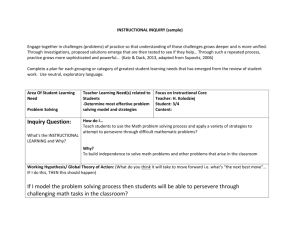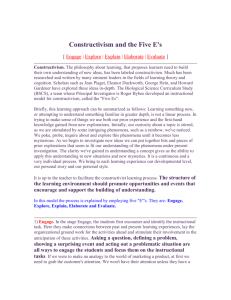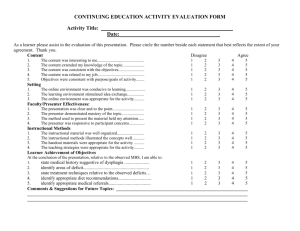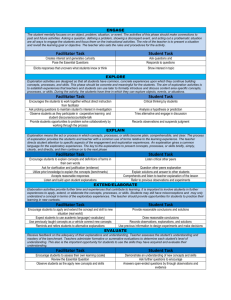"5 E`s" instructional model
advertisement
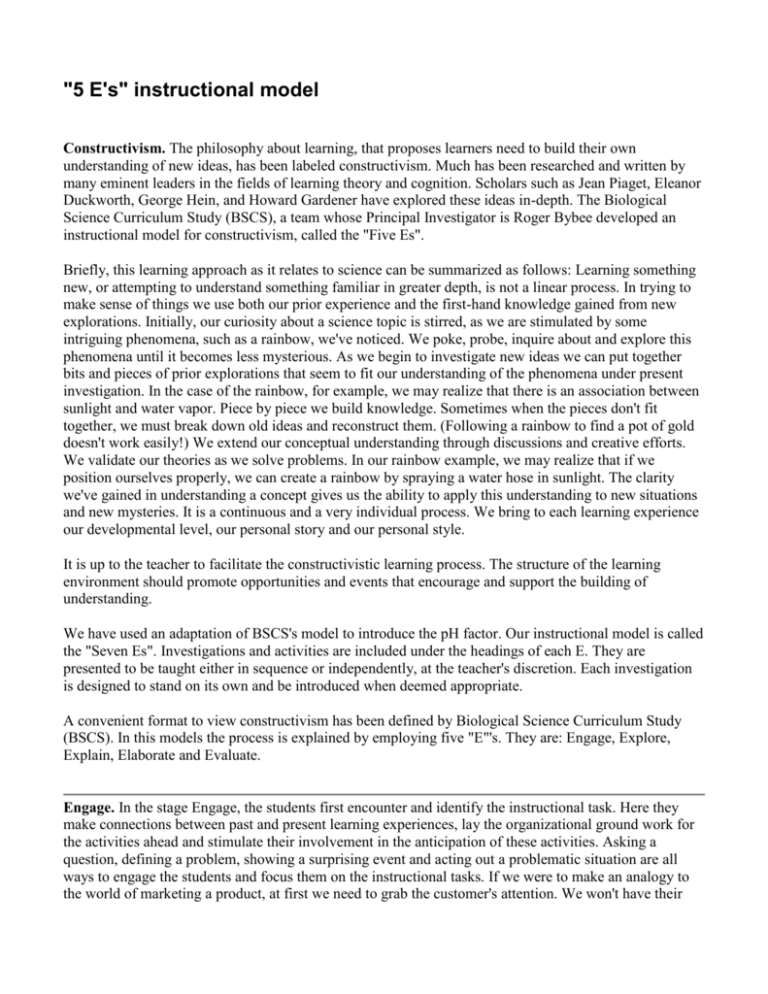
"5 E's" instructional model Constructivism. The philosophy about learning, that proposes learners need to build their own understanding of new ideas, has been labeled constructivism. Much has been researched and written by many eminent leaders in the fields of learning theory and cognition. Scholars such as Jean Piaget, Eleanor Duckworth, George Hein, and Howard Gardener have explored these ideas in-depth. The Biological Science Curriculum Study (BSCS), a team whose Principal Investigator is Roger Bybee developed an instructional model for constructivism, called the "Five Es". Briefly, this learning approach as it relates to science can be summarized as follows: Learning something new, or attempting to understand something familiar in greater depth, is not a linear process. In trying to make sense of things we use both our prior experience and the first-hand knowledge gained from new explorations. Initially, our curiosity about a science topic is stirred, as we are stimulated by some intriguing phenomena, such as a rainbow, we've noticed. We poke, probe, inquire about and explore this phenomena until it becomes less mysterious. As we begin to investigate new ideas we can put together bits and pieces of prior explorations that seem to fit our understanding of the phenomena under present investigation. In the case of the rainbow, for example, we may realize that there is an association between sunlight and water vapor. Piece by piece we build knowledge. Sometimes when the pieces don't fit together, we must break down old ideas and reconstruct them. (Following a rainbow to find a pot of gold doesn't work easily!) We extend our conceptual understanding through discussions and creative efforts. We validate our theories as we solve problems. In our rainbow example, we may realize that if we position ourselves properly, we can create a rainbow by spraying a water hose in sunlight. The clarity we've gained in understanding a concept gives us the ability to apply this understanding to new situations and new mysteries. It is a continuous and a very individual process. We bring to each learning experience our developmental level, our personal story and our personal style. It is up to the teacher to facilitate the constructivistic learning process. The structure of the learning environment should promote opportunities and events that encourage and support the building of understanding. We have used an adaptation of BSCS's model to introduce the pH factor. Our instructional model is called the "Seven Es". Investigations and activities are included under the headings of each E. They are presented to be taught either in sequence or independently, at the teacher's discretion. Each investigation is designed to stand on its own and be introduced when deemed appropriate. A convenient format to view constructivism has been defined by Biological Science Curriculum Study (BSCS). In this models the process is explained by employing five "E"'s. They are: Engage, Explore, Explain, Elaborate and Evaluate. Engage. In the stage Engage, the students first encounter and identify the instructional task. Here they make connections between past and present learning experiences, lay the organizational ground work for the activities ahead and stimulate their involvement in the anticipation of these activities. Asking a question, defining a problem, showing a surprising event and acting out a problematic situation are all ways to engage the students and focus them on the instructional tasks. If we were to make an analogy to the world of marketing a product, at first we need to grab the customer's attention. We won't have their attention unless they have a need to buy the product. They may be unaware of a need, and in this case we are motivated to create a need. Explore. In the Exploration stage the students have the opportunity to get directly involved with phenomena and materials. Involving themselves in these activities they develop a grounding of experience with the phenomenon. As they work together in teams, students build a base of common experience which assists them in the process of sharing and communicating. The teacher acts as a facilitator, providing materials and guiding the students' focus. The students' inquiry process drives the instruction during an exploration. Explain. The third stage, Explain, is the point at which the learner begins to put the abstract experience through which she/he has gone /into a communicable form. Language provides motivation for sequencing events into a logical format. Communication occurs between peers, the facilitator, or within the learner himself. Working in groups, learners support each other's understanding as they articulate their observations, ideas, questions and hypotheses. Language provides a tool of communicable labels. These labels, applied to elements of abstract exploration, give the learner a means of sharing these explorations. Explanations from the facilitator can provide names that correspond to historical and standard language, for student findings and events. For example a child, through her exploration, may state they have noticed that a magnet has a tendency to "stick" to a certain metallic object. The facilitator, in her discussion with the child, might at this stage introduce terminology referring to "an attracting force". Introducing labels, after the child has had a direct experience, is far more meaningful than before that experience. The experiential base she has built offers the student an attachment place for the label. Common language enhances the sharing and communication between facilitator and students. The facilitator can determine levels of understanding and possible misconceptions. Created works such as writing, drawing, video, or tape recordings are communications that provide recorded evidence of the learner's development, progress and growth. Elaborate. In stage four, Elaborate, the students expand on the concepts they have learned, make connections to other related concepts, and apply their understandings to the world around them. For example, while exploring light phenomena, a learner constructs an understanding of the path light travels through space. Examining a lamp post, she may notice that the shadow of the post changes its location as the day grows later. This observation can lead to further inquiry as to possible connections between the shadow's changing location and the changes in direction of the light source, the Sun. Applications to real world events, such as where to plant flowers so that they receive sunlight most of the day, or how to prop up a beach umbrella for shade from the Sun, are both extensions and applications of the concept that light travels in a straight path. These connections often lead to further inquiry and new understandings. Evaluate. Evaluate, the fifth "E", is an on-going diagnostic process that allows the teacher to determine if the learner has attained understanding of concepts and knowledge. Evaluation and assessment can occur at all points along the continuum of the instructional process. Some of the tools that assist in this diagnostic process are: rubrics (quantified and prioritized outcome expectations) determined hand-in-hand with the lesson design, teacher observation structured by checklists, student interviews, portfolios designed with specific purposes, project and problem-based learning products, and embedded assessments. Concrete evidence of the learning proceed is most valuable in communications between students, teachers, parents and administrators. Displays of attainment and progress enhance understanding for all parties involved in the educational process, and can become jumping off points for further enrichment of the students' education. These evidences of learning serve to guide the teacher in further lesson planning and may signal the need for modification and change of direction. For example, if a teacher perceives clear evidence of misconception, then he/she can revisit the concept to enhance clearer understanding. If the students show profound interest in a branching direction of inquiry, the teacher can consider refocusing the investigation to take advantage of this high level of interest. Viewing the evaluation process as a continuous one gives the constructivistic philosophy a kind of cyclical structure. The learning process is open-ended and open to change. There is an on going loop where questions lead to answers but more questions and instruction is driven by both predetermined lesson design and the inquiry process. Excite . . . stimulates the learner's curiosity. The hook What the student does that is consistent with this model: Shows interest in the topic by asking questions, such as: "Why did this happen?" "What do I already know about this?" "What can I find out about this?" What the teacher does that is consistent with this model: Creates interest Generates curiosity Raises questions Elicits responses that uncover what the students know or think about the concept/topic Explore . . . to satisfy curiosity. What the student does that is consistent with this model: Uses inquiry to explore and investigate; to satisfy his/her curiosity about the chosen concept/topic. Thinks freely, but within the limits of the activity. Tests predictions and hypotheses. Forms new predictions and hypotheses. Experiments with alternatives and discusses then with others. Records observations and ideas. Suspends judgements. What the teacher does that is consistent with this model: Encourages the students to work together with minumum supervision. Observes and listens to the students. Asks probing questions to redirect the students' investigations when necessary. Provides time for students to work through problems. Acts as a facilitator. pH Panel Click on ANY part of the panel to explore pH. Explain . . . the concept and define the terms. What the student does that is consistent with this model: Uses various informational resources, group discussions, and teacher interaction to derive definitions and explanations of the chosen concept. Explains possible solutions or answers to others' explanations. Listens critically to others' explanations. Questions others' explanations. Listens to and tries to comprehend explanations the teacher offers. Refers to previous activities. Uses recorded observations in explanations. What the teacher does that is consistent with this model: Encourages the students to explain concepts and definitions. Asks for justification (evidence) and clarification from students. Formally provides definitions, explanations, and new labels. Uses students' previous experiences as the basis for explaining new concepts. Expand . . . discovering new applications. What the student does that is consistent with this model: Applies new labels, definitions, explanations and skills in new, yet similar situations. Uses previous information to ask questions, propose solutions, make decisions, and design experiments. Draws reasonable conclusions from evidence. Records observations and explanations. Checks for peer understanding. What the teacher does that is consistent with this model: Expects the students to use formal labels, definitions, and explanations provided previously. Encourages the students to apply or extend the concepts and skills in new situtations. Reminds students of the existing evidence and data and asks: o What do you already know? o Why do you think . . . Extend . . . the concept into other content areas. What the student does that is consistent with this model: Makes connections and sees relationships of the concept/topic in other content areas. Forms expanded understanding of original concepts/topics. Makes connections of concept/topic to real world situations. What the teacher does that is consistent with this model: Looks for concepts connecting with other concepts/topics and/or with other content areas. Asks probing questions to help students see relationships between concept/topic and other content areas. Exchange . . . ideas, lesson plans, or experiences. What the student does that is consistent with this model Shares information about the concept/topic with others via cyberspace. Collaborates by sharing interest with others via cyberspace. What the teacher does that is consistent with this model Shares information about the concept/topic with others via cyberspace. Collaborates by sharing interest and/or activities with others via cyberspace. Examine . . . the student's understanding. What the student does that is consistent with this model Answers open-ended questions by using observations, evidence, and previously accepted explanations. Demonstrates an understanding or knowledge of the concept or skill. Evaluates his or her own progress and knowledge. Uses alternative assessments to demonstrate their understanding of the concept/topic. What the teacher does that is consistent with this model Observes the students as they apply new concepts and skills. Assesses students' knowledge and/or skills. Looks for evidence that the students have changed their thinking or behaviors. Allows students to assess their own learning and group-process skills. Asks open-ended questions like: o Why do you think . . . ? o What evidence do you have? o What do you know about . . . ? o How would you explain . . . ? "5 E's" instructional model The Voyages Through Time (VTT) curriculum uses the "5 E's" instructional model developed by the Biological Sciences Curriculum Study (BSCS) [Bybee, R. W. (Ed.). National Standards and the Science Curriculum: Challenges, Opportunities, and Recommendations. Dubuque, Iowa: Kendall-Hunt Publishers, 1966]. This guided inquiry approach involves students in actively developing their understanding of concepts or skills with the teacher acting as the instructional director. The "5 E's" instructional model involves specified sequence of phases: Engage, Explore, Explain, Elaborate, and Evaluate. Each phase has a particular purpose. The nature of the instructional task during each phase can and does vary from activity to activity, but the purpose of each phase remains the same. The "5 E's" provides the framework for the VTT activities. In some VTT activities, the "5 E's" sequence plays out across two, fifty-minute classes, and there will be an additional "engage" for the second class. There are also a few activities that have a double explore-explain, such that the sequence is engageexplore-explain-explore-explain-elaborate-evaluate. Engage: This phase initiates an activity. Its primary purpose is to introduce students to the concept, process, or skill that will be explored. The engage phase often involves one or more of the following, as well: making connections with prior instruction, anticipating the upcoming tasks, identifying learning objectives, and/or clarifying students' current ideas and skills. Clarifying students' current ideas and skills may involve reminding them of or reviewing with them prerequisites necessary for the upcoming tasks. In some instances, it may involve making both the teacher and the students aware of potential alternative conceptions (a.k.a., misconceptions). Such conceptions are not corrected at this point; the exploration and explanation phases are designed to challenge alternative conceptions. It is important to bring these conceptions to the forefront so that they can be re-examined in light of new information developed during the exploration phase. Explore: This phase provides students with a common base of experiences with natural phenomena. These experiences may involve observations of events or objects, manipulations of materials, work with simulations, examinations of representations, viewing a short video, or reading about a scientist's work. These experiences provide a common basis for all students that the teacher can use to assist them in identifying and developing concepts and skills. Students make records of their experiences during the explore phase and sometimes answer questions about them, although these do not go beyond initial analyses. Explain: At the beginning of this phase in the instructional model, students are provided with opportunity to verbalize their understanding of their experiences from the explore phase. The questions and discussion lead students to patterns, regularities, and/or similarities and prompt them to describe concepts or skills in their own words. This largely student-directed portion of the explain phase may occur in small groups or as a whole class. The teacher then introduces a label or term and provides a formal definition or description for the concept or skill. Elaborate: The next phase challenges students to extend their understandings or skills and/or to practice them. Through new experiences at this time, students develop deeper understanding, an extended conceptual framework, and/or improved skills. Some of the tasks, such as reading an article, may be done as homework and discussed during the following class period. Evaluate: The final phase of the instructional model encourages students to assess their understanding and abilities and provides opportunity for the teacher to evaluate student progress toward achieving the learning objectives for the activity. The tasks may involve writing summaries, applying concepts and/or skills to novel situations, constructing a concept map, or taking a quiz. Some evaluate tasks are done as homework. Group work in VTT When students are not engaged in whole class tasks, teachers are usually directed to have them work in pairs or small groups of three or four. The VTT curriculum uses this organizational approach, rather than having students work independently, for two reasons. The first, practical reason is to reduce the amount of materials and equipment needed. The second, and more important reason, is to encourage students to talk with each other. Talking out loud about what one is observing and doing promotes attention to the task and its salient characteristics. Talking through the meaning of what one has seen requires putting one's ideas into words that can be understood by someone else. This promotes more careful reasoning and clarity of expression. Learn more about using our lesson plans Nortel LearniT Lesson Plans and the 6ES Model of Instruction Nortel LearniT is pleased to present lessons constructed using a model we are confident will assist you to provide high quality learning experiences to your students. The lesson plans on this site are based on constructivist instructional models with activities and sections of the plan designed to have the students continually add (or construct) new knowledge on top of existing knowledge. The 6E's lesson plan format was developed by teachers in consultation with faculty from schools of education in North America and is based on a constructivist model of teaching. The model we have developed is called the 6ES Model of Instruction (6 E's and an S--Engage, Explore, Explain, Elaborate, Evaluate, Extend, and Standards). Teacher Instructions: This section is designed to provide you, the teacher, with an overview of the lesson and some of the preparation and prerequisite requirements. It is our intention to ensure that you have a complete and accurate picture of the lesson before you take the time to download the plan. The following six sections (the 6ES Model) should be distributed to your students for them to follow the project instructions. Engage: This is the section where the topic is introduced in an interesting way. It is an opportunity to provide some information but to encourage the students to seek out new information. Often this section will arouse a student's curiosity, violate their current notions of the way things ought to be or incite them to pursue answers to their own questions. It is important not to provide them with everything they need to know, but more the motivation to find out. Each lesson plan has an 'essential question' that is the basis for their inquiry. Normally the section will include a few key questions to help direct some of the research in the Explore section. Explore: This is the section where the student investigates the topic more thoroughly. In these lessons the investigation takes the form of Internet research but it could equally include original research and the use of a variety of problem solving techniques. What is important is that the students are given the opportunity to "free wheel" their way through the materials and not be over directed. We all know however, that they will need some direction and the teacher can circulate, asking important questions, listening to their interactions and ensuring that they remain on task. Explain: As teachers, we will all have to resist the urge to be the ones that do the explaining at this point. This section provides the student with the opportunity to "explain" or in some way demonstrate their grasp of the concepts after completing their research. Normally this section will contain key questions and/or instruction for requiring the student to provide a summary of what they have learned in the Explore section. This can and should, where possible, take the form of class or group discussion as well. Elaborate: In this section of the lesson plan the students are expected to work directly on the given assignment. It is their opportunity to demonstrate their application of new information and to present their findings or conclusions to others. It is a good time for submitting materials for evaluation, doing presentations and completing the project or assignment. Evaluate: While it is expected that evaluation will continue throughout the process, this is the section where the teacher evaluates the learning that has occurred. We have provided some tools and suggestions for evaluation but anticipate that teachers will want to adapt these tools for their own use. Students normally submit their work or assignments at this point. It is very important at this stage that the students be encouraged to engage in self-evaluation, group evaluation and develop their own tools to do so. Extend: This section contains some suggestions for taking the students beyond the lesson. The purpose is to examine ways in which they can bring their findings to others or apply their understanding to new and unfamiliar circumstances. Normally, this type of activity will grow out of their excitement for what they have accomplished. This section is highly student driven, though teachers may want to gently suggest that the students enter their work in a competition or take their displays to other locations outside of their own school. Standards: Standards are currently in the process of being integrated, lesson plan by lesson plan. In this section, the lessons are matched with State, Provincial and/or national standards. It is primarily for the information of the teacher and should provide the information necessary to incorporate the lesson into the local board, district or school curriculum.

